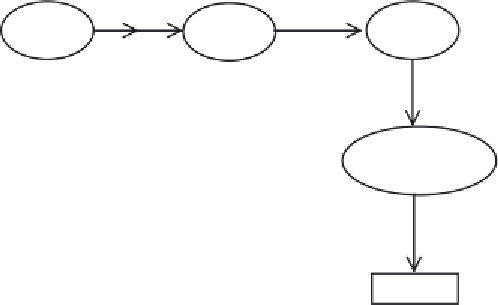Biomedical Engineering Reference
In-Depth Information
IL-3
GM-CSF
IL-3
Stem cell
CFU-MEG
CFU-GEMM
TPO
Megakaryocyte
TPO
Platelets
Figure 10.6
Simplifi ed representation of the production of platelets from stem cells. CFU-megakaryocytes
and in particular, mature megakaryocytes, are most sensitive to the stimulatory actions of TPO. These two cell
types also display a limited response to IL-6, IL-11 and LIF
radio-therapy. This indication generally accounts for up to 80 per cent of all platelet transfusions
undertaken. In the USA alone, close to 2 million people receive platelet transfusions annually.
Platelets (thrombocytes) carry out several functions in the body, all of which relate to the arrest
of bleeding. They are disc-shaped structures 1-2
m in diameter, and are present in the blood of
healthy individuals at levels of approximately 250 × 10
9
l
1
. They are formed by a lineage-specifi c
stem cell differentiation process, as depicted in Figure 10.6. The terminal stages of this process
entail the maturation of large progenitor cells termed 'megakaryocytes'. Platelets represent small
vesicles that bud off from the megakaryocyte cell surface and enter the circulation.
µ
10.3 Growth factors and wound healing
The wound healing process is complex and not yet fully understood. The area of tissue damage
becomes the focus of various events, often beginning with immunological and infl ammatory
reactions. The various cells involved in such processes, as well as additional cells at the site of the
wound, also secrete various growth factors. These mitogens stimulate the growth and activation
of various cell types, including fi broblasts (which produce collagen and elastin precursors, and
ground substance), epithelial cells (e.g. skin cells) and vascular endothelial cells. Such cells
advance healing by promoting processes such as granulation (growth of connective tissue and
small blood vessels at the healing surface) and subsequent epithelialization. The growth factors
that appear most signifi cant to this process include FGFs, TGFs, PDGF, IGF-1 and EGF.
Wounds can be categorized as acute (healing quickly on their own) or chronic (healing slowly,
and often requiring medication). Chronic wounds, such as ulcers (Table 10.9), occur if some
infl uence disrupts the normal healing process. Such infl uences can include diabetes, malnutrition,
rheumatoid arthritis and ischaemia (inadequate fl ow of blood to any part of the body). Elderly
people are particularly susceptible to developing chronic wounds, often resulting in the necessity
for hospitalization. Ulceration (particularly of the limbs or extremities) associated with old age,

Search WWH ::

Custom Search